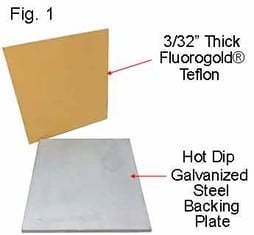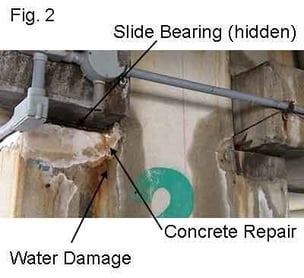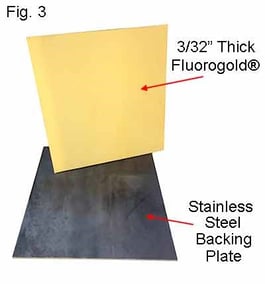Teflon® or Fluorogold® Slide Bearings are engineered to wear out. Like any sacrificial structural component, the idea is to protect the more critical, expensive or impossible to replace members. By design, the Teflon® surface should be where all the wear occurs. Ideally, the steel backing plate should never be the part that causes the bearing to be replaced.
The basic Slide Bearing configuration is 3/32” thick Teflon®, Glass Reinforced Teflon® or Fiberglass Reinforced Fluorogold®, which is then bonded to a steel backing plate. Most often, the backing plate is normal plain finish carbon steel. (Note: We can manufacture Slide Bearings to any dimensions a project requires.)
To view alternative Slide Bearing configurations click here.
Remember, the steel backing plate serves two functions:
First, it provides a perfectly flat surface. When bonded to the Teflon® or Fluorogold® it will ensure the entire sliding surface is making contact. Second, the backing plate can be welded to the steel members. Once installed the backing plate should not be subject to any wear from the friction created by movement.
With Slide Bearings intended for protected interior locations, the plain steel backing plate is more than adequate. The steel should easily outlive the Teflon® surface. Where backing plate issues become significant is on Slide Bearing Assemblies installed in exterior locations or in caustic environments.
Multiple story parking garages, highway overpasses, oil pipelines, etc. all have the added dimension of steel decay. Even interior applications such as automobile tunnels, manufacturing plants that employ solvents and even food processing facilities can subject the steel to corrosive vapors.
 If a designer feels the steel requires extra protection, the first level would be Hot Dip Galvanized steel backing plates. (Fig. 1) This is a more involved process than would appear, due to the system of bonding. The steel plate is hot dip galvanized first. Then, in a very time consuming process, the zinc coating is milled off the side of the plate that will mate with the Teflon®. From there the normal bonded process resumes.
If a designer feels the steel requires extra protection, the first level would be Hot Dip Galvanized steel backing plates. (Fig. 1) This is a more involved process than would appear, due to the system of bonding. The steel plate is hot dip galvanized first. Then, in a very time consuming process, the zinc coating is milled off the side of the plate that will mate with the Teflon®. From there the normal bonded process resumes.
Note: In our experience Galvanized Slide Bearings are always intended to be Hot Dip Galvanized. While Mill Galvanized steel will function, the zinc coating is very thin by comparison and will not afford the longevity of Hot Dip Galvanizing.
 This situation often occurs in highway overpasses, stadiums and parking garages. The Slide Bearing will sit on a flat concrete surface, usually part of a column or pier. As shown in Fig. 2, this is a lower floor on a multi-story parking garage.
This situation often occurs in highway overpasses, stadiums and parking garages. The Slide Bearing will sit on a flat concrete surface, usually part of a column or pier. As shown in Fig. 2, this is a lower floor on a multi-story parking garage.
Water continually runs down through the expansion joints and pools on the flat surface the Slide Bearing sits on. The water stains and concrete patches are evidence of the damage. Being continually wet causes decay on the Slide Bearing backing plate.
 Teflon®, PTFE, and Fluorogold® all stand up well to wet environments. The water itself will do more damage to the steel backing plate than the Teflon®. What will cause problems is the sand, sediment and debris that get carried along with the water. These will find their way onto the bearing surface, become embedded and act as abrasives as the bearing expands and contracts.
Teflon®, PTFE, and Fluorogold® all stand up well to wet environments. The water itself will do more damage to the steel backing plate than the Teflon®. What will cause problems is the sand, sediment and debris that get carried along with the water. These will find their way onto the bearing surface, become embedded and act as abrasives as the bearing expands and contracts.
For the most corrosive applications, the engineer will require the steel backing plate be stainless steel. This provides the greatest assurance the plate will not decay. It does require some additional consideration.
To review Slide Bearing installation information click here.
The backing plate will be welded to an underlying steel member that will most likely be carbon steel. Most slide bearings are set in place and welded in the field, so it is important the welder takes the dissimilar metals into account. It is also important to remember the heat of the welding process can melt the glue that is bonding the Teflon® or Fluorogold ® to the steel. For intermittent tack welds, excessive heat is usually not a problem. If the welds will be continuous enough, heat can develop to cause delamination which would lead to premature failure.





